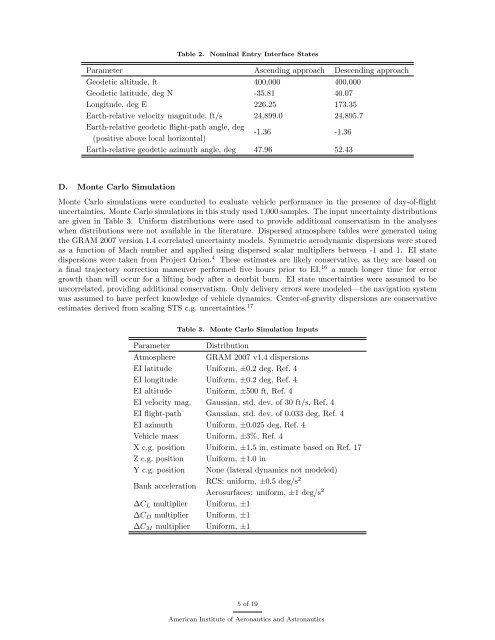Variable Angle-of-Attack Profile Entry Guidance for a Crewed Lifting ...
Variable Angle-of-Attack Profile Entry Guidance for a Crewed Lifting ...
Variable Angle-of-Attack Profile Entry Guidance for a Crewed Lifting ...
Create successful ePaper yourself
Turn your PDF publications into a flip-book with our unique Google optimized e-Paper software.
Table 2.<br />
Nominal <strong>Entry</strong> Interface States<br />
Parameter Ascending approach Descending approach<br />
Geodetic altitude, ft 400,000 400,000<br />
Geodetic latitude, deg N -35.81 40.07<br />
Longitude, deg E 226.25 173.35<br />
Earth-relative velocity magnitude, ft/s 24,899.0 24,895.7<br />
Earth-relative geodetic flight-path angle, deg<br />
(positive above local horizontal)<br />
-1.36 -1.36<br />
Earth-relative geodetic azimuth angle, deg 47.96 52.43<br />
D. Monte Carlo Simulation<br />
Monte Carlo simulations were conducted to evaluate vehicle per<strong>for</strong>mance in the presence <strong>of</strong> day-<strong>of</strong>-flight<br />
uncertainties. Monte Carlo simulations in this study used 1,000 samples. The input uncertainty distributions<br />
are given in Table 3. Uni<strong>for</strong>m distributions were used to provide additional conservatism in the analyses<br />
when distributions were not available in the literature. Dispersed atmosphere tables were generated using<br />
the GRAM 2007 version 1.4 correlated uncertainty models. Symmetric aerodynamic dispersions were stored<br />
as a function <strong>of</strong> Mach number and applied using dispersed scalar multipliers between -1 and 1. EI state<br />
dispersions were taken from Project Orion. 4 These estimates are likely conservative, as they are based on<br />
a final trajectory correction maneuver per<strong>for</strong>med five hours prior to EI, 16 a much longer time <strong>for</strong> error<br />
growth than will occur <strong>for</strong> a lifting body after a deorbit burn. EI state uncertainties were assumed to be<br />
uncorrelated, providing additional conservatism. Only delivery errors were modeled—the navigation system<br />
was assumed to have perfect knowledge <strong>of</strong> vehicle dynamics. Center-<strong>of</strong>-gravity dispersions are conservative<br />
estimates derived from scaling STS c.g. uncertainties. 17<br />
Table 3.<br />
Monte Carlo Simulation Inputs<br />
Parameter Distribution<br />
Atmosphere GRAM 2007 v1.4 dispersions<br />
EI latitude Uni<strong>for</strong>m, ±0.2 deg, Ref. 4<br />
EI longitude Uni<strong>for</strong>m, ±0.2 deg, Ref. 4<br />
EI altitude Uni<strong>for</strong>m, ±500 ft, Ref. 4<br />
EI velocity mag. Gaussian, std. dev. <strong>of</strong> 30 ft/s, Ref. 4<br />
EI flight-path Gaussian, std. dev. <strong>of</strong> 0.033 deg, Ref. 4<br />
EI azimuth Uni<strong>for</strong>m, ±0.025 deg, Ref. 4<br />
Vehicle mass Uni<strong>for</strong>m, ±3%, Ref. 4<br />
X c.g. position Uni<strong>for</strong>m, ±1.5 in, estimate based on Ref. 17<br />
Z c.g. position Uni<strong>for</strong>m, ±1.0 in<br />
Y c.g. position None (lateral dynamics not modeled)<br />
Bank acceleration<br />
RCS: uni<strong>for</strong>m, ±0.5 deg/s 2<br />
Aerosurfaces: uni<strong>for</strong>m, ±1 deg/s 2<br />
∆C L multiplier Uni<strong>for</strong>m, ±1<br />
∆C D multiplier Uni<strong>for</strong>m, ±1<br />
∆C M multiplier Uni<strong>for</strong>m, ±1<br />
5 <strong>of</strong> 19<br />
American Institute <strong>of</strong> Aeronautics and Astronautics
















